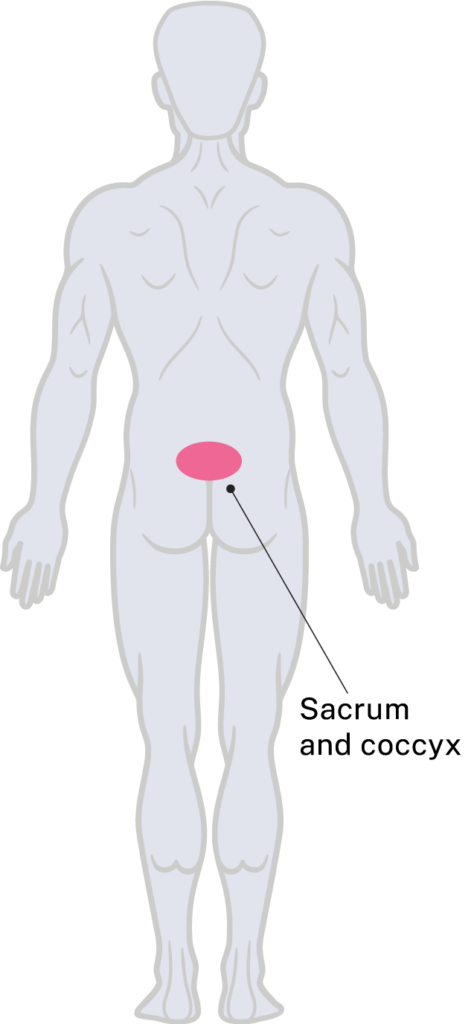Sacrum and coccyx
Specific risks
Seated surfaces and activities that cause increased pressure, shear and friction to the sacrum and coccyx include:
- Spending prolonged periods sitting up in bed
- Suboptimal seated posture — a posterior pelvic tilt and kyphotic posture increase loading on the sacrum and coccyx
- Cushions, particularly those that have ‘bottomed out’
- Backrests
- Other seating surfaces such as sports chairs, car seats, flooring/ground surfaces, dining chairs, lounge chairs, outdoor furniture, tub transfer benches, or static shower chairs
- Transfers that involve contact with the rear wheels of a manual wheelchair
- Sliding down or forward in the wheelchair, in bed, or in a sling
- Bulky clothing such as low waistbands or incontinence pads
- Inadequate frequency or quality of pressure relief
- Muscle wasting or weight loss
These areas should be assessed by palpating for boggy, soft, or tender areas that may indicate early tissue damage.

Management of breakdown
- Review and identify causative factors such as the mattress, cushion, showering aids, other seated surfaces, transfers, clothing, muscle bulk, care routines and continence management.
- Sitting may be appropriate only if there is no contact with any of the following:
- Backrest
- Sling
- Cushion
- Showering and toileting aids including toilet seat, shower commode aperture, or tub transfer bench.
- Avoid transferring and sitting in the car until the wound is healed and a return to sitting program has been completed.
- Review commode seat and consider using a commode seat design with a rear-opening aperture. Closely assess the skin while seated on the commode seat to ensure there is no pressure, shear or tension being put through the area.
- Review the wheelchair set-up and posture.
- Sitting in a wheelchair may be possible with custom seating. Rehabilitation Engineering Centre, Surgical Treatment and Rehabilitation Service (STARS) can be consulted for advice.
The contact details are:
email: STARS_REHABENG@health.qld.gov.au or
phone: (07) 3647 6070
Stage 3 or 4 pressure injuries may require a surgical consult.
For urgent consultation
On-call Consultant Spinal Injuries Unit,
Princess Alexandra Hospital Ipswich Road,
Woolloongabba, Queensland.
Switch: (07) 3176 2111
Ask for the SIU Registrar on business days or an on-call SIU Consultant during after-hours for the Spinal Injuries Unit.
For a review at the Spinal Injuries Unit outpatient department
Referrals can be faxed through the central intake hub on 1300 364 248.
To link with community services
Contact Spinal Outreach Team at 3176 9507 or spot@health.qld.gov.au
Check out other pressure injury locations and learn how to manage them.